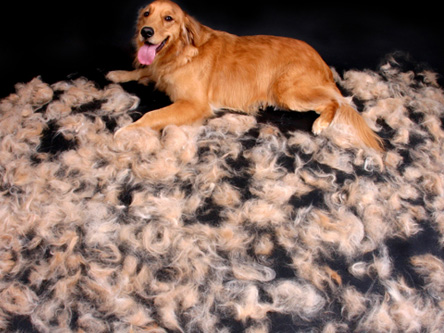“Anybody who doesn’t know what soap tastes like never washed a dog.” ~Franklin P. Jones
If you have a dog that develops a thick coat during the winter and when spring comes sheds significantly, so that the furniture and floors begin to resemble your canine companion, you are not alone.
From a scientific perspective, according to Dr.Danny W. Scott, professor at the College of Veterinary Medicine at Cornell, the reduction in sunlight and temperature during the winter trigger hormonal responses that grow additional fur, and the spring triggers the growth to stop and shedding begins. Therefore, indoor dogs experience less shedding compared with those that spend a significant amount of time in the outdoors.
Brushing a dog routinely is the most important method for handling shedding because it removes excess fur repeatedly so that less of it accumulates on the dog and the floor, furniture, clothing and all other surfaces it inhabits during the dreaded season. Regular bathing may also help to remove excess fur and condition the skin.
An effective stainless steel comb that can remove the undercoat effectively when the groomer exerts a normal amount of effort is the Furminator, which is a comb product specifically designed to help with shedding. The price is approximately $39, and many experts and customers advocate for its effectiveness online.
Some dogs shed more than others. A dog with a heavy overcoat, such as a Newfoundland or Malamute sheds heavily. A Poodle and Yorkshire Terrier shed less because the hair shaft lasts longer in these breeds, or the Bichon and Shih Tzu has minimal undercoat.
Cleaning dog hair from furniture may be an simple as vacuuming or brushing a damp cloth across the surface. Other tips include using a clean rubber glove to gather the fur.
A healthy diet may minimize shedding. According to the host of “Ask Marc, The Petkeeper” on Martha Steward Living Radio, Marc Morrone, feeding a dog healthy pet food can regulate the shedding, sometimes reducing it or easing the transition. It supports the dog’s body systems and encourages easing the transition from furry to fur-less. A healthy dog food lists meat as the first ingredient and may also include flax seed oil and other natural additives, but no foreign sounding terms that may cause allergies or otherwise complicate your pet’s body’s functions.
